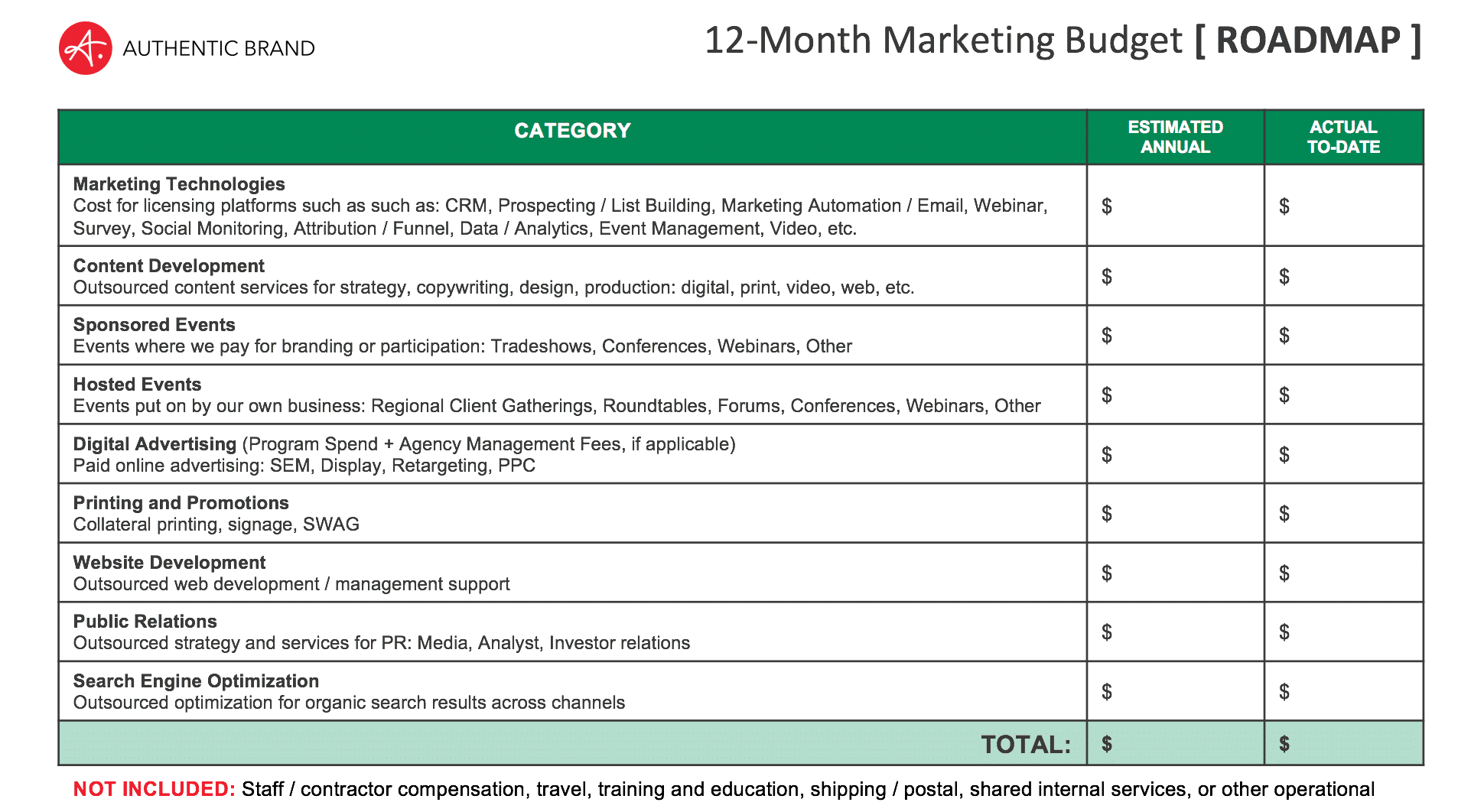Is Your Marketing Muscle Weak? Five indications that you need to pump some serious marketing iron

It’s a common situation for growing businesses: marketing is one of the last roles in the company to be prioritized. And it makes sense, to a certain point. Many businesses reach their first $5M, $10M, or even $50M through a focused sales-led effort, building relationships and expanding accounts and referrals. But for most of these organizations, there comes a time somewhere along the way where growth becomes unsustainable without a marketing engine in place to create early-stage interest and pipeline. That’s usually when Authentic enters the conversation.
Building a healthy business is a lot like building a healthy body: Needs change over time.
I’m a prime example. When I was in my twenties, I took up running. In my thirties (and after three babies), my body started sending me signals, warning me that running alone was not going to be sustainable. My needs were changing, and I had to adapt. I learned that a combination of cardio, strength and flexibility were all essential to maintaining a healthy balance. I needed to engage new muscles in new ways.
In our work as fractional CMOs and coaches, we see a lot of familiar “symptoms” when we first engage with a potential customer. These are the pains that bring us to the table, and the problems that we help to solve. They are all indications of “marketing muscle weakness,” and are common among businesses who have been running hard on the sales track, but who haven’t made marketing a core discipline of their growth regimen. The good news? All of these symptoms can be cured through consistent marketing exercise.
Five Symptoms of Weak Marketing Muscle
1. The CEO or VP of Sales Owns Marketing
The first (and arguably, most important) piece of scaling a business is learning how to delegate. I can’t tell you how often I talk with a CEO / Founder / Owner who is leading a $10/20/50M business and still owns marketing. Not because they are expert marketers, but because the marketing function has nowhere else to go in the business, so it falls back on them (and subsequently, gets pushed to the back burner).
Some leaders will try to fix this problem by assigning marketing to the head of sales. Now, I’m not opposed to marketing and sales being linked together on the accountability chart. I’m a big fan of a unified revenue-focused team and structure. But when a sales leader is in charge of the marketing plan, it rarely works. Why? First, because most sales leaders don’t actually have any experience building marketing programs and teams. They may understand the importance of marketing, but they likely don’t understand how to make marketing work. And the marketing landscape is becoming more complex by the day.
If your sales leader is trying to stay up to speed on marketing, chances are, they’re taking their eye off the sales ball. Which brings me to my next point. Sales reps and leaders are motivated and measured by what is immediately in front of them: the next meeting, the next proposal, the next win. Marketing requires a much longer-term view: building a brand that engages audiences well before they know they have a need and nurturing them into potential sales prospects over time. The best person to own this responsibility is a marketer, working closely with executive and sales leadership to ensure that everyone is aligned toward the end goal, which is measurable revenue.
2. No Established Marketing Budget
Unless you’re an externally-funded SaaS/software company, you probably didn’t launch your business with a six-figure marketing budget. But if you’re a $5M+ business, and you still haven’t put together a marketing budget and plan, you have a gap. It is surprising to me how many successful, established businesses are still “winging it” when it comes to marketing spend. Investments are made reactively, often based on the latest shiny object or sales request (what we call “random acts of marketing”), and without an integrated strategy or clear boundaries for decision-making.
What’s worse is that many businesses can’t accurately account for marketing spend in any given year, because they borrow from other budgets (sales, operations, IT) without tracking back to specific activities. Without clear tracking of spend, and in the absence of an integrated strategy, there is essentially no way to measure ROI.
This is why so many CEOs and CFOs recoil at the word “marketing”. It’s the big, black hole of spend. And in that state, marketing will always be the last area of the business prioritized, and the first area of the business to get cut. The ramifications of this cycle are deadly for any business intent on growth.
For most small- to mid-sized businesses, the marketing program budget should be fairly simple and flexible. You’ll need room to adjust as you gather insights on what works best and as your business cycles ebb and flow. When we work with customers to assemble a marketing roadmap, a high-level budget is a key part of the deliverable. The following template provides an example of the common categories we see in a B2B marketing plan. Every budget is unique based on the business model and industry, but most companies will leverage some aspect of these categories into their mix.

Authentic: Marketing Roadmap 12-Month Budget
3. Lack of Marketing Cadence
I have yet to meet a CEO or head of Sales who doesn’t have a big vision for what is possible for business growth. But good ideas and the best of intentions are never going to move the needle, at least not consistently. One of the most effective ways to build marketing muscle is to get in the habit of iterative planning and execution.
I know, I know. It’s not sexy. But if you want sexy results, you have to get very good at repeatable processes. As I said earlier, building a strong business is a lot like building a healthy body. Being a weekend warrior at the gym may have worked for you in your twenties, but at some point, an occasional workout is not enough to sustain a healthy fitness level. Doing occasional and random acts of marketing may have worked in the early stages of your business, but that approach won’t drive a healthy, predictable pipeline.
In my past roles as a marketing leader for fast-growing businesses, I lived by two mantras (which I now preach to our customers):
“What gets documented gets done.” and “Progress eats perfection for breakfast every day.”
The key is to keep the marketing plan simple, actionable, flexible, and measurable. But you do have to document it. If you don’t, it won’t happen. So put it to paper, and make sure your key internal stakeholders are aligned. And then start. Just start. And learn quickly. It’s better to beat your competition to market with something good than to wait for something to be perfect and miss the opportunity to win. And as you start, learn. As you learn, adjust. And the key to doing all of this successfully is to make sure you have the process in place to activate, measure and move forward.
The Authentic model is designed to help our customers build this cadence – and strengthen their marketing muscle – by using an annual/quarterly/weekly meeting rhythm that is proven to work and drive accountability.
This blog elaborates on the key ingredients of the Authentic process (our Authentic Growth Methodology TM), which I recommend for any business committed to making marketing a strategic priority.
4. Wrong Metrics
In a world of exponential data, so many companies still struggle to define marketing metrics that actually matter. Companies with weak marketing muscle tend to focus on engagement metrics: visitors, clicks, opens, likes, shares, downloads, followers, and attendees. These metrics are easy to capture and interesting to watch from a trends perspective. They can be helpful indicators of success, but they can also be incredibly deceptive. Who cares if your site gets several thousand visitors a day if none of them are your ideal buyers? What does it matter if your event was well-attended if there are no decision-makers in the room? Businesses with a strong marketing discipline understand that the most important measure of all is sales, and unless your marketing metrics tie back to pipeline, all of the engagement in the world doesn’t really matter.
It’s easy to overdo things when it comes to metrics and data. Too much data becomes a distraction. We advise our customers to focus on three to five key metrics that will help them understand the impact of their marketing programs. As your programs and systems evolve, so will your metrics: providing more historical truth and predictive insight. If you haven’t built processes for marketing data capture and review in the past, you’ll likely have to start with a period of building and baselining. You may have to invest in new systems (CRM or marketing automation), develop new standards and processes, and train your teams on data input and management. It will be painful and tedious for a while, but the intelligence you gain as a result will be well worth the effort.
If you’re currently focused on engagement metrics, here are some ideas to jump-start your thinking about defining new metrics that tie back to sales impact:
- Total Number of Inbound Leads (Phone calls, website forms, emails, referrals)
- Lead Source (What content or channels do your leads come from?)
- Lead to Pipeline Conversion (What number / percent of all leads turn into legitimate sales opportunities / proposals?)
- Win / Loss Rate (What percent of all opportunities do you win / lose / defer?)
- Win / Loss Reason (Why do you win some deals, and why do you lose others? I suggest capturing this as data, but also in a marketing and sales conversation.)
5. Messaging is Stuck at “What”
I wrote an entire blog and did a podcast on this topic, so I won’t over-elaborate here, but I will provide the following modified excerpt to tie off on this topic.
Before your business pumps up its marketing muscle, it’s imperative that you lay the groundwork for meaningful engagement, and that all begins with crafting a message that is tailored to your buyers. It sounds easy, but if it were, most businesses would have this nailed. And surprisingly, most don’t. In fact, most businesses suffer from myopia when it comes to messaging. They are simply too close to the subject matter to see objectively and struggle to translate their value proposition in a way that resonates with the buyer.
As a result, most businesses end up with a story that looks and sounds just like their competitors. I call this a What Message: What we do, who we are, how we deliver. It’s business-focused, rather than customer-focused. A What Message isn’t a bad thing. In fact, it plays a critical role in creating internal alignment: helping team members see where the flag is planted, and where everyone should be focused. But many businesses confuse their What Message with a go-to-market, customer-facing story. And that, it is not.
Businesses with strong marketing discipline value brand messaging. They understand that a What Message makes them a commodity among a sea of competitors, so they invest the time and resources to build a clear, differentiated and customer-focused message. We call this a So What Message, and you can learn more about that here.
If any of these five symptoms feel familiar, we’d love to chat with you. We’re in the business of helping growing companies build strong marketing muscles that drive sales. Contact us to arrange for a no-cost, no-obligation diagnostic, and let’s discover how Authentic brand can support and coach you to next-level growth.
